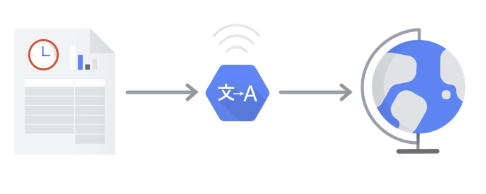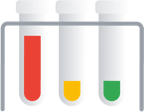Introduction
Imagine you run a financial reporting service that has an opportunity to expand to new countries. Those markets require that your time-sensitive financial documents are translated in real time. Instead of hiring bilingual finance staff or contracting with a specialist translator, both of which come at a high price due to their domain expertise and your need for quick turnaround, AutoML Translation can help you automate the translation job in a scalable way, allowing you to enter new markets quickly.

Try it for yourself
If you're new to Google Cloud, create an account to evaluate how Cloud Translation performs in real-world scenarios. New customers also get $300 in free credits to run, test, and deploy workloads.
Try Cloud Translation freeWhy is Machine Learning (ML) the right tool for this problem?
 Classical programming requires the programmer to specify step-by-step instructions
for the computer to follow.
But this approach quickly gets unfeasible for translation. Natural language is
complex, and translating it is too — rule-based translation stopped being the
best approach decades ago. Now machine translation is done almost entirely
with a statistical approach, with massive parallel corpora taking the place
of linguistic experts fine-tuning ever more specialized sets of rules by hand.
Classical programming requires the programmer to specify step-by-step instructions
for the computer to follow.
But this approach quickly gets unfeasible for translation. Natural language is
complex, and translating it is too — rule-based translation stopped being the
best approach decades ago. Now machine translation is done almost entirely
with a statistical approach, with massive parallel corpora taking the place
of linguistic experts fine-tuning ever more specialized sets of rules by hand.
You need a system that can generalize to a wide variety of translation scenarios, but is laser-focused on your use case and task-specific linguistic domain in the language pairs you care about. In a scenario where a sequence of specific rules is bound to expand exponentially, you need a system that can learn from examples. Fortunately, machine learning systems are well-positioned to solve this problem.
Is the Translation API or AutoML Translation the right tool for me?
The Translation API covers a huge number of language pairs and does a great job with general-purpose text. Where AutoML Translation really shines is for the "last mile" between generic translation tasks and specific, niche vocabularies. Our custom models start from the generic Translation API model, but add a layer that specifically helps the model get the right translation for domain-specific content that matters to you.

| Try the Translation API | Get started with AutoML |
What does machine learning in AutoML Translation involve?
 Machine learning involves using data to train algorithms to achieve a desired
outcome. The specifics of the algorithm and training methods change based on
the problem space. There are many different subcategories of machine learning,
all of which solve different problems and work within different constraints.
AutoML Translate enables you to perform supervised learning, which involves
training a computer to recognize patterns from translated sentence pairs.
Using supervised learning, we can train a custom model to translate
domain-specific content you care about.
Machine learning involves using data to train algorithms to achieve a desired
outcome. The specifics of the algorithm and training methods change based on
the problem space. There are many different subcategories of machine learning,
all of which solve different problems and work within different constraints.
AutoML Translate enables you to perform supervised learning, which involves
training a computer to recognize patterns from translated sentence pairs.
Using supervised learning, we can train a custom model to translate
domain-specific content you care about.
Data Preparation
In order to train a custom model with AutoML Translation, you supply matching pairs of sentences in the source and target languages - that is, pairs of sentences that mean the same thing in the language you want to translate from and the one to which you want to translate. Of course, translation isn't an exact science, but the closer in meaning your sentence pairs are, the better your model will work.
Assess your use case

While putting together the dataset, always start with the use case. You can begin with the following questions:
- What is the outcome you’re trying to achieve?
- What kinds of sentences do you need to translate to achieve this outcome? Is this a task that the Translation API can do out of the box?
- Is it possible for humans to translate these sentences in a way that satisfies you? If the translation task is inherently ambiguous, to the point where a person fluent in both languages would have a hard time doing a satisfactory job, you may find AutoML Translation to be similar in performance.
- What kinds of examples would best reflect the type and range of data your system will need to translate?
A core principle underpinning Google's ML products is human-centered machine learning, an approach that foregrounds responsible AI practices including fairness. The goal of fairness in ML is to understand and prevent unjust or prejudicial treatment of people related to race, income, sexual orientation, religion, gender, and other characteristics historically associated with discrimination and marginalization, when and where they manifest in algorithmic systems or algorithmically aided decision-making. You can read more in our guide and find "fair-aware" notes ✽ in the guidelines below. As you move through the guidelines for putting together your dataset, we encourage you to consider fairness in machine learning where relevant to your use case.
Source your data
 Once you've established what data you will need, you need to find a way to
source it. You can begin by taking into account all the data your organization
collects. You may find that you're already collecting the data you would need
to train a translation model. In case you don't have the data you need, you can
obtain it manually or outsource it to a third-party provider.
Once you've established what data you will need, you need to find a way to
source it. You can begin by taking into account all the data your organization
collects. You may find that you're already collecting the data you would need
to train a translation model. In case you don't have the data you need, you can
obtain it manually or outsource it to a third-party provider.
Match data to your problem domain
 You're training a custom translation model because you need a model that fits
a particular linguistic domain. Make sure your sentence pairs do the best
possible job of covering the vocabulary, usage, and grammatical quirks of your
industry or area of focus. Find documents that contain typical usages you'd
find in the translation tasks you want accomplished, and make sure your parallel
phrases match as closely in meaning as you can arrange. Of course, sometimes
languages don't map perfectly in vocabulary or syntax, but try to capture the
full diversity of semantics you expect to encounter in use if that's possible.
You're building on top of a model that already does a pretty good job with
general-purpose translation - your examples are the special last step that
makes AutoML Translation work for your use case in particular, so make sure
they're relevant and representative of usage you expect to see.
You're training a custom translation model because you need a model that fits
a particular linguistic domain. Make sure your sentence pairs do the best
possible job of covering the vocabulary, usage, and grammatical quirks of your
industry or area of focus. Find documents that contain typical usages you'd
find in the translation tasks you want accomplished, and make sure your parallel
phrases match as closely in meaning as you can arrange. Of course, sometimes
languages don't map perfectly in vocabulary or syntax, but try to capture the
full diversity of semantics you expect to encounter in use if that's possible.
You're building on top of a model that already does a pretty good job with
general-purpose translation - your examples are the special last step that
makes AutoML Translation work for your use case in particular, so make sure
they're relevant and representative of usage you expect to see.
Capture the diversity of your linguistic space
 It's tempting to assume that the way people write about a specific domain is
uniform enough that a small number of text samples translated by a small
number of translators should be sufficient to train a model that works well for
anyone else writing about that domain. But we're all individuals, and we each
bring our own personality to the words we write. A training dataset with sentence
pairs from a broad selection of authors and translators is more likely to give
you a model that's useful for translating writing from a diverse organization.
In addition, consider the variety of sentence lengths and structures; a dataset
where all the sentences are the same size or share a similar grammatical structure
will not give AutoML Translation enough information to build a good model
that captures all the possibilities.
It's tempting to assume that the way people write about a specific domain is
uniform enough that a small number of text samples translated by a small
number of translators should be sufficient to train a model that works well for
anyone else writing about that domain. But we're all individuals, and we each
bring our own personality to the words we write. A training dataset with sentence
pairs from a broad selection of authors and translators is more likely to give
you a model that's useful for translating writing from a diverse organization.
In addition, consider the variety of sentence lengths and structures; a dataset
where all the sentences are the same size or share a similar grammatical structure
will not give AutoML Translation enough information to build a good model
that captures all the possibilities.
Keep humans in the loop
 If it's at all feasible, make sure a person who understands both languages well
has validated the sentence pairs match up correctly and represent understandable,
accurate translations. A mistake as simple as misaligning the rows of your
training data spreadsheet can yield translations that sound like nonsense.
High-quality data is the most important thing you can provide to AutoML Translation
to get a model that's usable for your business.
If it's at all feasible, make sure a person who understands both languages well
has validated the sentence pairs match up correctly and represent understandable,
accurate translations. A mistake as simple as misaligning the rows of your
training data spreadsheet can yield translations that sound like nonsense.
High-quality data is the most important thing you can provide to AutoML Translation
to get a model that's usable for your business.
Clean up messy data
 It's easy to make mistakes when preprocessing data, and some of those mistakes
can really confuse an AutoML Translation model. In particular, look for
the following data issues that you can fix:
It's easy to make mistakes when preprocessing data, and some of those mistakes
can really confuse an AutoML Translation model. In particular, look for
the following data issues that you can fix:
- Remove duplicate source sentences, particularly if they have different target translations. AutoML Translation uses only the first seen example and drops all other pairs at import time. By removing duplicates, you ensure AutoML Translation uses your preferred translation.
- Align source sentences to the correct target sentences.
- Match sentences to the specified language; for example, include only Chinese sentences in a Chinese dataset.
- For target sentences that include mixed languages, check that untranslated words are intentionally untranslated, such as names of products or organizations. Target sentences that mistakenly include untranslated words add noise to your training data, which can result in a lower quality model.
- Fix sentences with typographical or grammatical errors so that your model doesn't learn these errors.
- Remove non-translatable content such as placeholder tags and HTML tags. Non-translatable content can result in punctuation errors.
- Remove locale-specific content. Information that is intended for different locals might not be direct translations such as phone numbers for a particular locale.
- Don't include translations that replace general entities with specific nouns. For instance, you might have an example that changes "president" to a name of a specific president like "JFK" or "John F Kennedy." The model might learn to change all instances of "president" to "JFK." Instead, remove these translations or change the specific nouns to a common one.
- Remove duplicate sentences in the training and test sets. (Learn more about train and test sets)
- Split multiple sentences into different sentence pairs. Training on a dataset where many items have more than about 50 tokens (words) in them yields lower quality models. Split items into individual sentences where possible.
- Use consistent casing. Casing affects how a model learns, for example, to distinguish a headline versus body text.
- Remove TMX tags when importing data to from a TSV file. In some cases, you might export your existing translation memory to a TSV file, which might include TMX tags. However, AutoML Translation cleans up translation unit tags only when you import TMX file (not for TSV files).
How AutoML preprocesses your data
AutoML Translation will stop parsing your data input file when:
- There is invalid formatting
- There is an unreasonably long sentence pair (10 MB)
- The file uses an encoding other than UTF-8
AutoML Translation ignores errors for problems it can detect, such as:
- A <tu> element in a TMX file doesn't have the source language or target language.
- One of the input sentence pairs is empty.
In AutoSplit mode, AutoML Translation does additional processing:
- After the dataset is uploaded, it removes sentence pairs with identical source sentences.
- It randomly splits your data into three sets with split ratio 8:1:1 before training.
Consider how AutoML Translation uses your dataset in creating a custom model
 Your dataset contains training, validation and testing sets. If you do not specify
the splits (see Preparing your training data and
your dataset contains under 100,000 sentence pairs, then AutoML Translation
automatically uses 80% of your content documents for training, 10% for
validating, and 10% for testing. If your data is larger than that, you'll need
to perform your own data split.
Your dataset contains training, validation and testing sets. If you do not specify
the splits (see Preparing your training data and
your dataset contains under 100,000 sentence pairs, then AutoML Translation
automatically uses 80% of your content documents for training, 10% for
validating, and 10% for testing. If your data is larger than that, you'll need
to perform your own data split.
Training Set
 The vast majority of your data should be in the training set. This is the data
your model "sees" during training: it's used to learn the parameters of the model,
namely the weights of the connections between nodes of the neural network.
The vast majority of your data should be in the training set. This is the data
your model "sees" during training: it's used to learn the parameters of the model,
namely the weights of the connections between nodes of the neural network.
Validation Set
 The validation set, sometimes also called the "dev" set, is also used during the
training process. During model learning, the framework uses the training set
to train a suite of candidate models, and then uses the model's performance on
the validation set to choose the best model generated. It uses the model's
performance on the validation set to tune the model's hyperparameters, which
are variables that specify the model's structure. If you used the training set
to tune the hyperparameters, the model would
end up overly focused on your training data. Using a somewhat novel dataset to
fine-tune model structure means your model will generalize better.
The validation set, sometimes also called the "dev" set, is also used during the
training process. During model learning, the framework uses the training set
to train a suite of candidate models, and then uses the model's performance on
the validation set to choose the best model generated. It uses the model's
performance on the validation set to tune the model's hyperparameters, which
are variables that specify the model's structure. If you used the training set
to tune the hyperparameters, the model would
end up overly focused on your training data. Using a somewhat novel dataset to
fine-tune model structure means your model will generalize better.
Test Set
 The test set is not involved in the training process at all. Once the model has completed its training entirely, we use the test set as an entirely new challenge
for your model. The performance of your model on the test set is intended to give
you a pretty good idea of how your model will perform on real-world data.
The test set is not involved in the training process at all. Once the model has completed its training entirely, we use the test set as an entirely new challenge
for your model. The performance of your model on the test set is intended to give
you a pretty good idea of how your model will perform on real-world data.
Manual Splitting
 AutoML can split your data into training, validation, and test sets for you,
or you can do it yourself if you want to exercise more control over the process,
if you'd prefer a different percentage split, or if there are specific examples
that you're sure you want included in a certain part of your model training lifecycle.
AutoML can split your data into training, validation, and test sets for you,
or you can do it yourself if you want to exercise more control over the process,
if you'd prefer a different percentage split, or if there are specific examples
that you're sure you want included in a certain part of your model training lifecycle.
Prepare your data for import

Once you’ve decided if a manual or automatic split of your data is right for you, there are two ways to add data in AutoML Translation:
- You can import data as a tab-separated values (TSV) file containing source and target sentences, one sentence pair per line.
- You can import data as a TMX file, a standard format for providing sentence pairs to automatic translation model tools (learn more about the supported TMX format). If the TMX file contains invalid XML tags, AutoML Translation ignores them. If the TMX file does not conform to proper XML and TMX format – for example, if it is missing an end tag or a <tmx> element – AutoML Translation will not process it. AutoML Translation also ends processing and returns an error if it skips more than 1024 invalid <tu> elements.
Evaluate
Once your model is trained, you will receive a summary of your model performance. Click the Train tab after the model has completed training to view a detailed analysis.
What should I keep in mind before evaluating my model?
 Debugging a model is more about debugging the data than the model itself. If your
model starts acting in an unexpected manner as you're evaluating its performance
before and after pushing to production, you should return and check your data to
see where it might be improved.
Debugging a model is more about debugging the data than the model itself. If your
model starts acting in an unexpected manner as you're evaluating its performance
before and after pushing to production, you should return and check your data to
see where it might be improved.
BLEU score
The BLEU score is a standard way to measure the quality of a machine translation system. AutoML Translation uses a BLEU score calculated on the test data you've provided as its primary evaluation metric. (Learn more about BLEU scores.)
The Google NMT model, which powers the Translation API, is built for general usage. It may not be the best solution for you if you are looking for specialized translation in your own fields. The trained custom model usually works better than the NMT model in the fields that your training set is related to.
After you train the custom model with your own dataset, the BLEU score of the custom model and Google NMT model will be shown in the Train tab. There is also a BLEU score performance gain from the custom model on the Train tab. The higher the BLEU score, the better translations your model can give you for sentences that are similar to your training data. If the BLEU score falls in the range 30-40, the model is considered to be able to provide good translations.
Testing your model
 Even if the BLEU score looks okay, it's a good practice to sanity check the model
yourself to make sure its performance matches your expectations. If your
training and test data are drawn from the same incorrect set of samples, the
scores might be excellent even if the translation is nonsense! Come up with
some sanity-check examples to input on the AutoML Translation Predict
tab and compare with the results from the Google NMT base model, or use the
instructions on that tab to call the AutoML API to use your model in automated
tests. You might notice that your model comes up with the same predictions as
the base model, especially on short sentences or if you have a smaller training
set. This isn't unexpected - the base model is already pretty good for a wide
variety of use cases. Try some longer or more complex sentences. However, if
all of your sentences come back identical to the predictions from the base
model, this may indicate a data problem.
Even if the BLEU score looks okay, it's a good practice to sanity check the model
yourself to make sure its performance matches your expectations. If your
training and test data are drawn from the same incorrect set of samples, the
scores might be excellent even if the translation is nonsense! Come up with
some sanity-check examples to input on the AutoML Translation Predict
tab and compare with the results from the Google NMT base model, or use the
instructions on that tab to call the AutoML API to use your model in automated
tests. You might notice that your model comes up with the same predictions as
the base model, especially on short sentences or if you have a smaller training
set. This isn't unexpected - the base model is already pretty good for a wide
variety of use cases. Try some longer or more complex sentences. However, if
all of your sentences come back identical to the predictions from the base
model, this may indicate a data problem.
If there's a mistake that you're particularly worried about your model making (for example, a confusing feature of your language pair that often trips up human translators, or a translation mistake that might be especially costly in money or reputation) make sure your test set or procedure covers that case adequately for you to feel safe using your model in everyday tasks.
